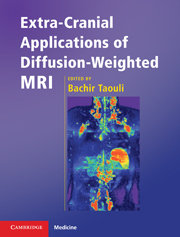Book contents
- Frontmatter
- Contents
- List of contributors
- Preface
- 1 Basic physical principles of body diffusion-weighted MRI
- 2 Diffusion-weighted MRI of the liver
- 3 Diffusion-weighted MRI of diffuse renal disease and kidney transplant
- 4 Diffusion-weighted MRI of focal renal masses
- 5 Diffusion-weighted MRI of the pancreas
- 6 Diffusion-weighted MRI of the prostate
- 7 Breast applications of diffusion-weighted MRI
- 8 Diffusion-weighted MRI of lymph nodes
- 9 Diffusion-weighted MRI of female pelvic tumors
- 10 Diffusion-weighted MRI of the bone marrow and the spine
- 11 Diffusion-weighted MRI of soft tissue tumors
- 12 Evaluation of tumor treatment response with diffusion-weighted MRI
- 13 Diffusion-weighted MRI: future directions
- Index
- References
9 - Diffusion-weighted MRI of female pelvic tumors
Published online by Cambridge University Press: 10 November 2010
- Frontmatter
- Contents
- List of contributors
- Preface
- 1 Basic physical principles of body diffusion-weighted MRI
- 2 Diffusion-weighted MRI of the liver
- 3 Diffusion-weighted MRI of diffuse renal disease and kidney transplant
- 4 Diffusion-weighted MRI of focal renal masses
- 5 Diffusion-weighted MRI of the pancreas
- 6 Diffusion-weighted MRI of the prostate
- 7 Breast applications of diffusion-weighted MRI
- 8 Diffusion-weighted MRI of lymph nodes
- 9 Diffusion-weighted MRI of female pelvic tumors
- 10 Diffusion-weighted MRI of the bone marrow and the spine
- 11 Diffusion-weighted MRI of soft tissue tumors
- 12 Evaluation of tumor treatment response with diffusion-weighted MRI
- 13 Diffusion-weighted MRI: future directions
- Index
- References
Summary
Introduction
Magnetic resonance imaging (MRI) plays essential roles at every stage in the management of patients with gynecological cancer, from initial diagnosis and lesion characterization, to assessments of treatment effectiveness as well as for the determination of the activity of residual disease and the detection of recurrent active cancer. The limitations of morphological MRI assessments are well documented. For example, the detection of malignant lesions can be difficult particularly when disease burden is small or when disease is intermixed with normal or benign disease processes (e.g., detecting a small endometrial cancer in an endometrial polyp). Similarly, diagnostic accuracy of myometrial invasion by endometrial cancer is impaired particularly in patients with distortions of the endometrial cavity due to congenital abnormalities or fibroids or when there is scarring due to prior surgery. Coincident adenomyosis or a thinned/indistinct junctional zone can also impair assessments of depth of tumor invasion. Lesion characterization can be equally problematic, for example differentiating uterine sarcoma from degenerating leiomyomas or determining the nature of an adnexal mass. Detection and assessment of the activity of residual disease is also problematic for morphology-based imaging; for example, subtle serosal disease due to ovarian carcinoma is easily overlooked. Finally, determining relapsed disease in areas of therapy-induced scarring can be problematic requiring careful comparisons to be made with prior examinations (e.g., it is often difficult to differentiate tumor recurrence from post-surgical/post-radiotherapy fibrosis following pelvic surgery).
- Type
- Chapter
- Information
- Extra-Cranial Applications of Diffusion-Weighted MRI , pp. 119 - 143Publisher: Cambridge University PressPrint publication year: 2010
References
- 1
- Cited by

